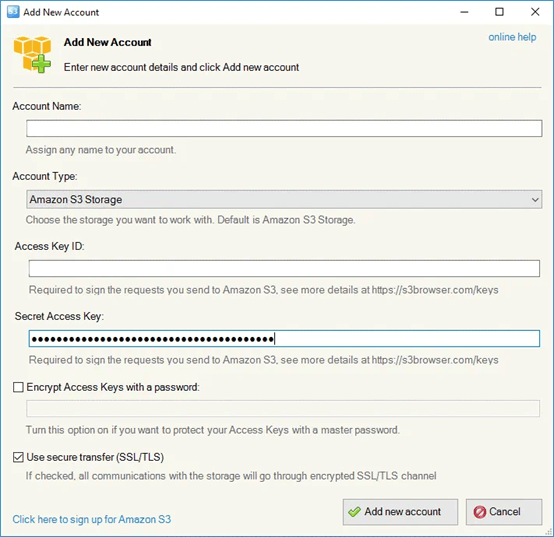Amazon S3 Browser makes it easier for users to leverage cloud storage for a variety of applications. Its simplicity, combined with the flexibility of S3, allows individuals and businesses to manage their cloud storage efficiently and with confidence.

Amazon S3 (Simple Storage Service) does not have a dedicated "browser" application in the traditional sense, but there are several tools and interfaces that can help you browse and manage your S3 storage such as AWS Management Console, AWS CLI and S3 Browser.
Amazon S3 Browser is designed for managing Amazon S3 buckets and objects. It's a graphical user interface (GUI) tool used to perform various operations on S3, such as uploading and downloading files, managing permissions, creating and deleting buckets, and other administrative tasks.

The Amazon S3 Browser for Windows allows you to perform a range of tasks, such as browsing S3 buckets, uploading and downloading files, managing permissions, and more. If you'd like to use the AWS S3 Browser for Windows, here's a guide on how to get started:
Step 1: Download and Install
Step 2: Add AWS Credentials

Step 3: Browse and Manage S3 Buckets
Step 4: Perform Basic Operations
◈ Upload Files:
◈ Download Files:
◈ Create Buckets:
◈ Delete Buckets and Objects:
Step 5: Manage Permissions and Bucket Policies
Step 6: Advanced Features
❈ Lifecycle Rules: You can set lifecycle rules for objects in a bucket, such as transitioning them to a different storage class or expiring them after a certain time such as
STANDARD
STANDARD_IA
ONEZONE_IA
DEEP_ARCHIVE
INTELLIGENT_TIERING
❈ Object Versioning: If versioning is enabled, you can manage object versions from the interface.
❈ Generate Presigned URLs: This feature allows you to create temporary URLs for public access to specific objects.
Backing up your data to a secure cloud service like Amazon S3 ensures that your critical information is protected and easily accessible whenever you need it. AOMEI Cyber Backup, integrated with Amazon S3, provides a powerful, efficient, and secure solution for backing up your critical data. By leveraging the strengths of both AOMEI Cyber Backup and Amazon S3, you can ensure that your data is protected against loss, easily recoverable, and stored in a highly durable and scalable cloud environment.
It simplifies the process of backing up data with its intuitive interface and advanced features, offering useful features like:
This guide will walk you through the steps to back up your data to Amazon S3 using AOMEI Cyber Backup. Download the professional backup software from the button below:
Follow these steps to back up files to Amazon S3 using AOMEI Cyber Backup:
1. Click Target Storage > Amazon S3 > Add Target to open the add target page. Enter your Amazon S3 credentials including username, keyword, and bucket name, then click Confirm. Ensure you have the necessary permissions set up in your AWS account.
2. Click Backup Task > Create New Task to starting archiving your important data to Amazon S3. Select File Backup (for example) and choose files or folders for backup.
3. Check Archiving backup versions to Amazon S3 and click Select to choose the added Amazon S3.
4. Schedule backup task to run daily/weekly/monthly, and select backup retention policies to delete old backups automatically.
5. Click "Start Backup" to begin the backup process. It will first create a backup locally or on the NAS and then upload the backup to Amazon S3. According to the 3-2-1 backup rule, this ensures that the security of critical data and business continuity.
Don't leave your data protection to chance. Start using AOMEI Cyber Backup with Amazon S3 today to implement a robust and reliable backup strategy. Try the centralized backup solution and learn to enhance your data protection efforts.
Q: Is the S3 browser free for commercial use?
A: The S3 Browser application is free for personal and commercial use. Also, S3 Browser also offers a paid "Pro" version with additional features that might be beneficial for more advanced use cases or for organizations that require additional capabilities.
If you have specific requirements or want advanced features, you can consider exploring the Pro version to see if it meets your needs. Otherwise, the free version should be sufficient for most standard S3 operations.
Q: How many buckets can I have in s3?
A: By default, Amazon S3 offers support for 100 buckets in each of the AWS accounts you hold. However, if you need more, you can bring that number to 1000 simply by submitting a service limit increase.
Q: Can I manage multiple Amazon S3 accounts with S3 Browser?
A: Yes, you can manage multiple S3 accounts, and also you can switch between different accounts.
Q: Does S3 Browser support file synchronization?
A: Yes, the S3 Browser includes features for file synchronization.
Whether you're a developer, data manager, or business owner, Amazon S3 Browser can simplify your interaction with S3. This guide covers the basics of getting started and performing common operations. With the ability to create presigned URLs, manage object versioning, and configure lifecycle rules, this tool caters to a range of use cases, from simple storage solutions to advanced cloud data management.